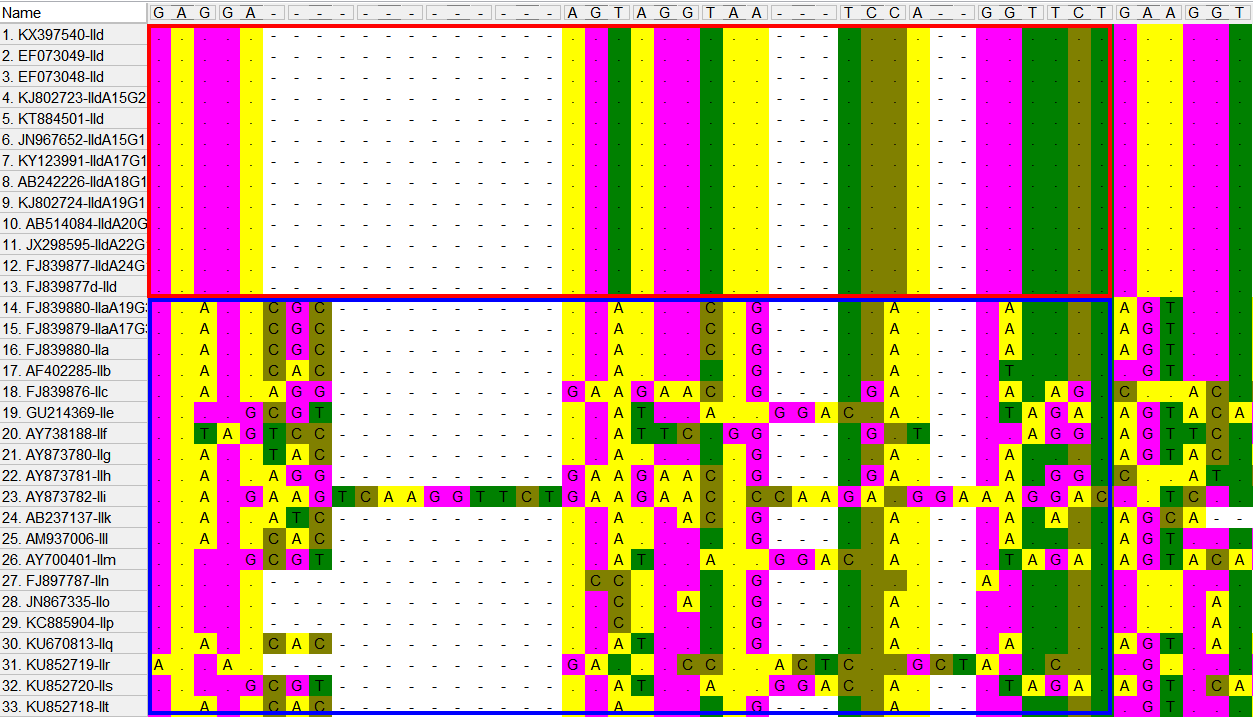Advanced Search
Selection of the Target DNA
The crRNA of Cas12a consists of two parts: the conserved direct repeat and the Spacer. The sequence of spacer region was reverse complementary to, and thus, determined by the selected Target DNA sequence. The first step of designing crRNA is to select a suitable Target DNA.
The gp60 gene has been used in the identification of subtype families (SF) of Cryptosporidium parvum, thus, we decided to select the appropriate Target DNA sequence from this gene. To ensure the specificity and sensitivity of the established detection method, the Target DNA sequence should fulfils the following criteria: conserved within and specific with IId SF of C. parvum.
To determine the highly conserved regions with SF specificity, sequences of the gp60 gene of different SFs were downloaded from GenBank and aligned using ClustalX 2.1 (http://www.clustal.org/clustal2/), and a 24-nucleotide (nt) sequence closely following a A nucleotide-rich (NAA) protospacer adjacent motif (PAM) was decided as the target DNA sequence (Fig. 1).

Fig. 1 Determination of the Target DNA sequence.
The conservation and heterogeneity of the selected Target sequence were indicated by red (the upper) and blue (the lower) rectangles, respectively.
Design of crRNA
The direct repeat of FnCas12a is 5’ – AAU UUC UAC UGU UGU AGA U – 3’. The Spacer sequence is reverse complementary to the selected Target DNA sequence, being 5’ – AGA ACC UGG AUU A CC UAC UUC CUC – 3’. Therefore, the complete crRNA sequence is 5’ – AAU UUC UAC UGU UGU AGA U aga acc ugg auu acc uac uuc cuc – 3’.
Preparation of crRNA
The homologous crDNA sequence is 5’ – gag gaa gta ggt aat cca ggt tct ATC TAC AAC AGT AGA AAT T – 3’, reverse complementary to the crRNA. The crRNA was prepared according the following protocols.
1). Add T7 promoter sequence (5’ – gaaatTAATACGACTCACTATAggg – 3’) to the 5' end of the crDNA sequence, then the single-stranded (ss) crDNA and its reverse complementary ss crDNA were synthesized by Sangon Biotech (Shanghai) Co., Ltd.
2). The synthesized ss crDNA was then annealed to double-stranded (ds) crDNA in Annealing buffer (Beyotime Biotechnology, Shanghai, China, Cat#D0251), complying with the manufacturer’s instructions. The Nuclease-Free Water was purchased from Solarbio Science & Technology (Beijing, China, Cat#R1600).
3). The crRNA was transcribed using HiScribe™ T7 High Yield RNA Synthesis Kit (New England Biolabs, Cat#E2040S) complying with the manufacturer’s instructions.
4). DNA templates were digested using DNase I (RNase Free) (Takara Biomedical Technology, Beijing, China, Cat#D2215), complying with the manufacturer’s instructions.
5). The purification of the transcribed crRNA was performed using NucAway™ Spin Columns (Life Technologies, USA, Cat#AM10070) under the manufacturer’s instructions.
Do you have any questions about this protocol?
Post your question to gather feedback from the community. We will also invite the authors of this article to respond.
Tips for asking effective questions
+ Description
Write a detailed description. Include all information that will help others answer your question including experimental processes, conditions, and relevant images.
Share
Bluesky
X
Copy link
